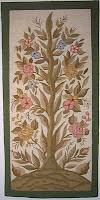Workshops
 |
| Janet & Carole give some care & handling tips |
We had two workshops this month, CCI's
Artifacts in Aboriginal Cultural Centres, and our own
Museum Management & Governance. CCI's workshop was very hands-on, and they brought some fantastic examples of Aboriginal object for us to discuss. The Management & Governance workshop was preceded by our first real blast of winter, but thankfully the weather was fine as we made our way to New Glasgow. It's hard to make this topic hands-on, but we had some great discussions and it was really interesting to watch the class grab onto certain pieces of information. There was some serious synchronized note-taking going on. We had great turnout for each, and are already talking about where and when the next workshops will take place (in the spring...no more winter travel). Thanks to the
Glooscap Heritage Centre and the
Museum of Industry for being excellent hosts.
Meetings
As I mentioned last month, we're garnering a lot of interest in our database renewal & website development work. This month I met with the
CNSA to discuss their review of Archway and how we are currently on very similar paths. The recent departmental shuffle has put museums, archives, and libraries all under the same umbrella, and there seems to be general agreement that this is an opportunity for us to work together and do some great things. Anita and I also sat down with some friends from the Heritage Division to talk about our process and the sharing of collections information online. We're going to keep these discussions going so we'll be better able to coordinate efforts as all of our projects continue to align. Very exciting times!
Also taking place right now are
Community Museum Assistance Program (CMAP) meetings. As the program is currently under review, community meetings are taking place in each of the regions to ensure that museums' input is incorporated into the final report. If you have not already attended one of these meetings, I strongly urge you to do so.
Here's the list of dates & places:
1. Northeast Region - November 23, 930am-1230pm - Marigold Cultural Centre, 605 Prince Street, Truro
2. Central Region - November 30, 1-4pm - Fairbanks Interpretative Centre, 54 Locks Road, Dartmouth
3. Cape Breton Region - December 1, 1-4pm (storm date Dec.2) - Highland Village Museum, Iona
4. Southwest Region - December 6, 1-4pm - Greenwood Military Aviation Museum, Greenwood
Database Renewal Project - Website Development
We received official word that our SDI funding application for website development was approved. So now we can start to use all that research and background work to kick things into high gear. Our goal is to have the website ready for my 2012 summer site visits. This way I can give sites a sneak peak of their data as it is presented in the site. The official launch will still be September, so we've got 10 months to clean things up.
Chris has just finished up all sorts of documentation and policies. They are in the final stages of approval and should start to appear in our resources section before Christmas. We've also revised the Passage Game Plan to better address public expectations. Here are the steps in a nutshell:
1. Enter all paper-based info, georeference objects
2. Do an inventory - fill in as many blank fields as possible and get a high-quality image of the object
3. Enrichment - conduct research to fill in more blanks and share personal stories for every object
4. Reconcile loans - there is no such thing as a permanent loan!
There will be an update to the system in the near future (before Christmas), which means that the database will be down for a few hours. Seth and I have been talking about this and will be sure to schedule it overnight so that it won't interfere with anyone's work. I'll be sure to send an email to everyone about the update when it is done.
 |
Tapestry
Les Trois Pignons Centre Culturel |
We are still making very excellent progress in the database. I want to commend you all for your hard work. I know it represents many hours and you've been fantastic about adjusting your work plan to prepare for our 2012 website launch. Kudos to you!
So where do we sit this month? Well, we added another 722 new records and 2,125 images! We now have 171,414 records and 41,820 images in the database. Yay team!
And now for that ever-popular regional breakdown:
Southwest - 83,904 artifacts, 17,323 images
Central - 34,735 artifacts, 8,696 images
Northeast - 32,461 artifacts, 12,599 images
Cape Breton - 22,014 artifacts, 3,202 images
Congrats to the
Central region for adding the most artifact records and images this month. They had some stiff competition from the Southwest for the artifact records, but blew everyone out of the water with the images.
I am amazed at how many images are being added each month. This is exactly the kind of progress we want to see as we work on website development. I've been getting questions about
artifact photography and the dating of artifacts since we have identified these tasks as priorities, so Chris and I are working on some blog posts to deal with these issues. Let me know if you have other areas that you'd like addressed and we'll do our best to accommodate.













 VS.
VS. 


 vs.
vs.























